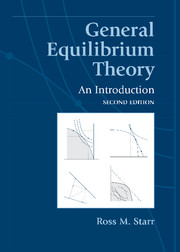Book contents
- Frontmatter
- Contents
- List of illustrations
- Introduction to the second edition
- Preface to the second edition
- Preface to the first edition
- Table of notation
- Table of assumptions
- A General equilibrium theory: Getting acquainted
- B Mathematics
- C An economy with bounded production technology and supply and demand functions
- D An economy with unbounded production technology and supply and demand functions
- E Welfare economics and the scope of markets
- F Bargaining and equilibrium: The core
- G An economy with supply and demand correspondences
- H Standing on the shoulders of giants
- Bibliography
- Index
Introduction to the second edition
Published online by Cambridge University Press: 05 June 2012
- Frontmatter
- Contents
- List of illustrations
- Introduction to the second edition
- Preface to the second edition
- Preface to the first edition
- Table of notation
- Table of assumptions
- A General equilibrium theory: Getting acquainted
- B Mathematics
- C An economy with bounded production technology and supply and demand functions
- D An economy with unbounded production technology and supply and demand functions
- E Welfare economics and the scope of markets
- F Bargaining and equilibrium: The core
- G An economy with supply and demand correspondences
- H Standing on the shoulders of giants
- Bibliography
- Index
Summary
The foundations of modern economic general equilibrium theory are contained in a surprisingly short list of references. For primary sources, it is sufficient to master Arrow and Debreu (1954), Arrow (1951), Arrow (1953), and Debreu and Scarf (1963). An even shorter list is comprehensive; Debreu (1959) and Debreu and Scarf (1963) cover the topic admirably. Why should anyone write (or read!) a secondary source, a textbook? Because, unfortunately, this body of material is extremely difficult for most students to read and comprehend. Professor Hahn described Debreu's (1959) book as “very short, but it may well take as long to read as many works three times as long. This is not due to faulty exposition but to the demands rigorous analysis makes on the reader. It is to be hoped that no one will be put off by this, for the … return … is very high indeed” (Hahn [1961]). Unfortunately, in teaching economic theory we find that many capable students are indeed put off by the mathematical abstraction of the above works. What theorists regard as elegantly terse expression, students may find inaccessible formality. The focus of this textbook is to overcome this barrier and to make this body of work accessible to a wider audience of advanced undergraduate and graduate students in economics.
This book presents the theory of general economic equilibrium incrementally, from elementary to more sophisticated treatments. Part A (Chapters 1 through 5) presents an elementary introduction.
- Type
- Chapter
- Information
- General Equilibrium TheoryAn Introduction, pp. xv - xxPublisher: Cambridge University PressPrint publication year: 2011
- 2
- Cited by



